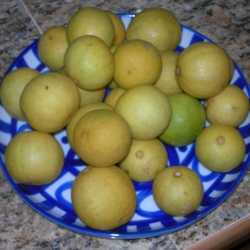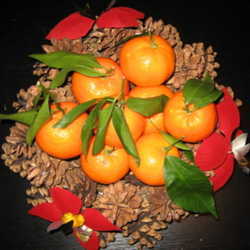T
The first lemon it bore weighed a ponderous 4 1/2 pounds! It made the local newspaper and provided me several weeks of teenage celebrity. Once the public show and tell was over, I was anxious to cut the lemon open. Although much larger than lemons at the store, the interior looked very lemon-like and was identical in taste.

My lemon tree's current home
The tree was about three feet tall when it first bloomed, its white flowers with purplish markings intensely fragrant. Not knowing much about citrus trees at the time, I was amazed when it developed menacing thorns on its branches and trunk, many over an inch long.
The 'Ponderosa' lemon tree (Citrus limon 'Ponderosa') is actually quite an old variety, having originated in 1886 as a seedling grown by George Bowman of Hagerstown, Maryland. It was named and introduced into the nursery trade in 1900. When grown in a container, it will rarely grow taller than six feet.
My own tree has truly led a charmed life, no thanks to me or my parents. It should have died long ago. I abandoned it while I was in college. My parents cared for it in my absence, religiously moving it outdoors during the growing season and bringing it back indoors when frost threatened in the fall. In the 1970s, my wife, daughter, and I moved to Alabama, once again leaving the lemon tree in my parents' care. During one of my father's regular Sunday evening phone calls, he told me that he was not bringing the damned (he actually used stronger language) lemon tree into the house for one more winter. At this point, I really didn't want the tree to perish, so I pleaded with him to bring it to Alabama. (He and my mother were planning to visit us several weeks later.) Reluctantly, he agreed. 
Flower buds and an immature fruit
When I greeted my parents on their arrival, there was no lemon tree in sight. Just as I inquired about its absence, my father opened the car trunk and pulled out a plastic bag. In it was the lemon tree, bare root and pruned back to a stump about two inches high! I potted it immediately, and contrary to my expectations, buds soon formed on the stub. Within several months, the tree had leafed out and was about two feet high by spring. It loved Alabama summers and rewarded us with several ripe lemons about every nine months or so.
The 1980s found us back home in Iowa, lemon tree and all. During its first year back, the tree developed a horrible infestation of scale insects. I cut it back to the main trunk, took a deep breath, then cut the trunk back to about a foot high. I gave it several rubbing alcohol baths and set it out in the blazing sun. I watered it daily and fed it high nitrogen fertilizer. To my amazement, it developed buds on its trunk yet again. By the end of summer the tree had grown so vigorously that it was almost back to its former self.
Blossoms about to open
I've kept a close eye on it ever since, but have had no more problems with scale or other insects. For the past decade it has been living year round in our basement under a single grow-light fluorescent fixture that gives it 14 hours of light a day. It blooms almost non-stop, hasn't been fertilized in years (except by our cat until we cat-proofed the pot), and still bears one or two ripe lemons at a time. Since there are no insects or breezes in its current environment, I pollinate the blossoms by hand.
Over the years, my wife has enjoyed using the lemons in her cooking as they ripen. We've graduated from simply making lemonade to trying some very interesting recipes. Below is one that is our current favorite and is most likely destined to become our all-time favorite lemon dessert.
If you'd like to try growing the tough-as-nails Ponderosa lemon, I've also listed some mail order sources for you below.
Ponderosa Lemon Tree Dwarf Citrus (formerly Acorn Springs Farm) Just Fruits and Exotics If you decide to order from one of the companies listed above, you can check out mail order companies right here at Dave's Garden by clicking on the "watchdog" image: Questions? Comments? Please scroll down to the form below. I enjoy hearing from readers! | Lemon Pavlova Meringue Lemon Filling Directions | 3. Whisk together the cinnamon and 1/4 cup sugar in a small bowl. Sprinkle cinnamon sugar, then almonds, evenly over meringue mixture. 4. Bake meringue in preheated oven until lightly brown, 12-15 minutes. Remove pan from oven. Turn over onto foil-covered surface, almond side down. Set aside to cool completely. Carefully remove parchment when cool. 5. Beat 3 egg whites until foamy in large glass or metal mixing bowl. Add salt, continuing to beat until stiff peaks form. Gradually beat in 1 cup sugar; then gradually beat in lemon juice and zest. 6. In a separate bowl, beat cream until stiff peaks form. Fold whipped cream into lemon mixture. 7. Place the filling in the center of the meringue. Using the foil to lift the meringue, fold the sides of the meringue over the filling, making a log shape. Wrap the log in foil and place in freezer for at least two hours. 8. To serve, unwrap pavlova. If desired, decorate with lemon slices, mint leaves, and strawberries. Serve slightly thawed. |
© Larry Rettig 2009


















